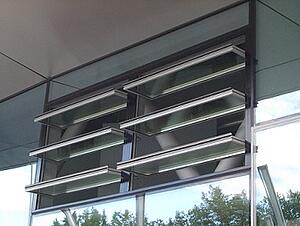 Glass louvred ventilators, or louvred window ventilators as they are commonly known, are becoming increasingly popular for use in natural and smoke ventilation systems. There are several suppliers on the market, offering products that vary widely in terms of performance and controls. How can you make sure you will get exactly what you need when specifying or purchasing one of these ventilators?
Glass louvred ventilators, or louvred window ventilators as they are commonly known, are becoming increasingly popular for use in natural and smoke ventilation systems. There are several suppliers on the market, offering products that vary widely in terms of performance and controls. How can you make sure you will get exactly what you need when specifying or purchasing one of these ventilators?
There are three critical considerations you should make when preparing to specify a glass louvred ventilator:
1. Testing: avoid bad surprises on quality
Surprisingly not all suppliers have fully tested their product to the current standards. To prevent quality issues, ensure that your ventilator has been fully tested in accordance with the following standards:
- EN 12101-2 (Smoke and heat exhaust ventilators)
- EN 14351-1 (Windows and doors)
- EN 1026 (Air permeability)
- EN 1027 (Watertightness)
- EN 12211 (Resistance to wind load)
It’s worth checking that all tests have been undertaken and the test report prepared by an independent accredited test institute.
Also, be aware that under the Construction Products Regulations it is now a legal requirement that smoke and heat exhaust ventilators are CE marked and certified to EN 12101-2 by a Notified Body.
2. Performance and Classification: not all ventilators are created equal!
Glass louvred ventilators often look similar, but this can hide vast differences in performance. We would recommend the following minimum performance standards are met and classified in accordance with the relevant EN standard:
- U value - 2.6 W/m2K
- Coefficient (Cv) - 0.58
- Air permeability - Class 3 (In accordance with EN 12207)
- Weathertightness - Class 4 A (In accordance with EN 12208)
- Resistance to wind load - Class A 5 (In accordance with EN 12210)
These are the classification standards based on testing to the standards listed in my first point.
3. Controls: the devil is in the detail
Each ventilator will come complete with its own control mechanism, whether it be a simple hand control or a sophisticated modulating, anti finger trapping actuator. Actuated control is the most common, as these products are mostly used at high and low level as part of a natural or smoke ventilation system.
In a future blog we will be discussing measures to assess the risk of finger trapping and possible measures to deal with it.
Define the system’s control at an early stage
You will very often find the wiring and control of these ventilators to be specified with a simple clause stating “control from the BMS system”. However, it is important to consider how the system will be controlled from an early stage and include a more detailed specification to prevent confusion.
Dual purpose ventilators are controlled by the smoke ventilation system
If the ventilators are dual purpose (day to day and smoke ventilation) then control of the system cannot be directly through the BMS; they will need to be controlled by a smoke ventilation control system. In this instance, one would normally provide a BMS link to the smoke ventilation control panel so that the system can operate as directed by the BMS in day to day mode and then switch to emergency mode in the event of a fire.
Natural ventilation can be controlled by the BMS but not powered by it
If the ventilators are for natural ventilation only, they can be controlled directly by the BMS. However, you should consider that the BMS will only provide a data signal and is not capable of powering the ventilator open or close. You will need local power units with reverse polarity relays for this. You may also require a transformer to reduce voltage from 230v to 24v depending upon the actuator.
Different ways of modulating the blades
Modulation of the blades is also commonly specified, though there are various ways to achieve this depending upon the actuator used. Some actuators require a power time delay module, some require special servo card modules, whist others have intelligent actuators which can modulate directly from the BMS signal. We'll come back to this subject in a future blog.
In conclusion: don’t feel shy about getting advice!
Most reputable suppliers will have control specialists who can help you with the control system; we recommend getting in touch with your supplier to discuss in more detail before specifying your glass louvred ventilators.
- Speak to a Colt specialist : Contact Colt
 Graeme Clark is a Senior Consultant for Colt UK and specialises in the design and product application of energy efficient HVAC and smoke control systems.
Graeme Clark is a Senior Consultant for Colt UK and specialises in the design and product application of energy efficient HVAC and smoke control systems.


